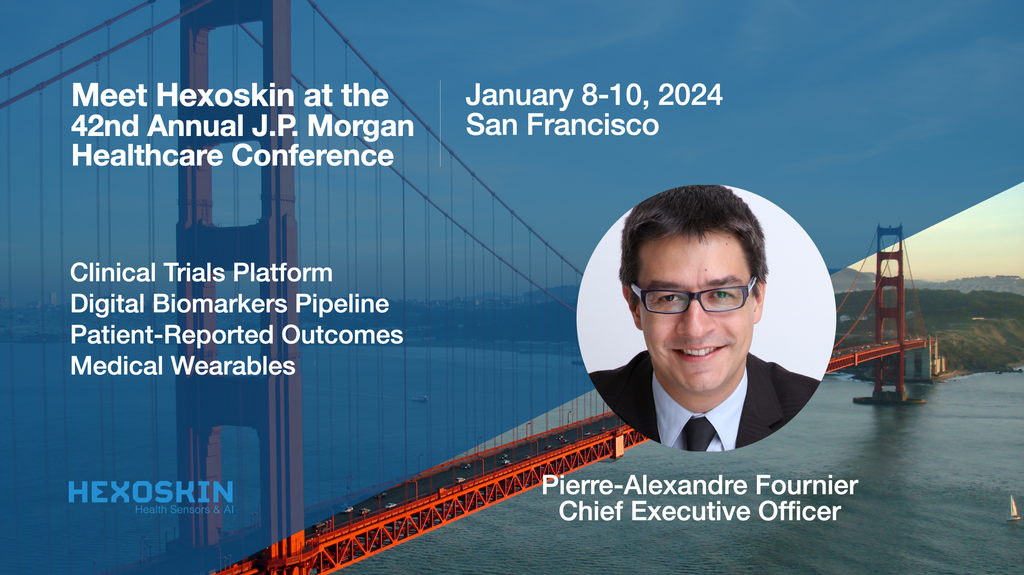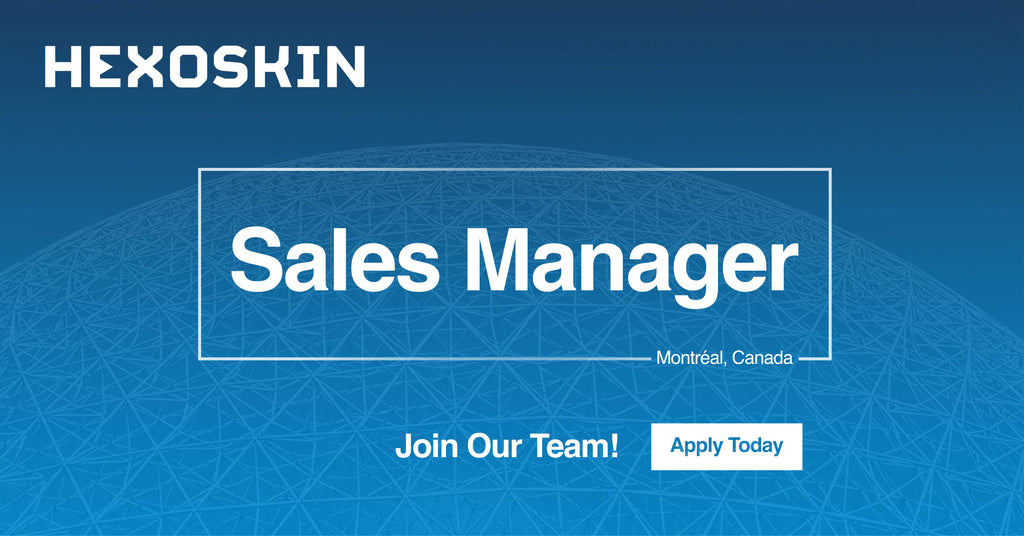- Continue Shopping
- Your Cart is Empty
Hexoskin Announces $4.2M Additional Funding Round and Acceleration of Clinical AI Development Platform
Montreal, Canada - August 27, 2024: Hexoskin, a Montreal-based digital health and AI company developing medical-grade wearables and algorithms for health monitoring and diagnostics, is very excited to announce today an additional USD $4.2M capital raise to invest in growth, digital biomarkers research, and new AI-based digital diagnostics solutions. Investors include AQC Capital and Anges Quebec (Canada), BDC Capital (Canada), ballas invest (Europe), Deep Divers Ltd (UK), and 19 other US and Canadian private investors.
Pierre-Alexandre Fournier, Hexoskin’s CEO, commented: “Hexoskin’s team has over 15 years of experience in clinical AI development and high-resolution wearable sensors. Our investors understand how our digital platform is uniquely positioned to develop a range of diagnostic tests and digital solutions that can address the needs of large populations in disease areas with large unmet needs, such as cardiac, respiratory and rare diseases.”
Hexoskin's current wearable sensing products (Hexoskin & Astroskin) serve the clinical research, defense, and aerospace markets. Its customers, including CSA, NASA, DOD, Yale Health, Boston Children's Hospital, and hundreds of research teams across the world, have published over 250 scientific papers with Hexoskin data. Hexoskin smart shirts are also used in pharma clinical trials, and its technology has been part of the International Space Station since 2019 to support clinical trials in space.
"We are excited to team up with Hexoskin and its investors to enable its next phase of development globally" said Laurent van Lerberghe, Co-Founder of ballas invest and former Chief Strategy Officer at Sanofi. "We have been impressed by the wealth of expertise accumulated by Hexoskin with trillions of data points, more than a hundred clinical trials, and over 250 peer-reviewed publications. Through novel higher resolution digital measures and digital biomarkers in clinical and real-world settings, Hexoskin is unlocking the possibilities of early disease detection, high quality monitoring, hence improving treatment decisions and patients’ quality of life".
Hexoskin’s software and wearable sensor products are used by clinical research teams around the world to collect digital endpoints in patient populations for a wide range of health conditions: cardiac (arrhythmias, heart rate variability), respiratory (CODP, asthma), cancer, neuro (dementia, epilepsy), rare diseases and pediatric research (Rett syndrome, ME/CFS, Long Covid).
"This additional equity funding allows us to better serve the scientific and medical communities," added Fournier. "Patients, healthcare providers, and researchers are looking for products that are accurate, validated in diverse populations, and easy to use to collect clinical data in real-world settings. Hexoskin’s solutions accomplish these goals, offering high-quality and reliable tools to improve patient outcomes through research and clinical care. Expanding our investor base from Canada to US and Europe is a clear marker of our global potential."
About Hexoskin
Hexoskin (Carré Technologies Inc.) is a pioneer in continuous, passive remote health monitoring driven by AI. Hexoskin's platform and technology are used by hundreds of institutional partners for research purposes, in studies examining breathing disorders, cardiac and pulmonary diseases, rare diseases, stress, sleep, epilepsy, and other conditions. If you're interested in investing in Hexoskin please consult our investor relations section.
An End-to-End Solution for Clinical Research
Launched in 2023, the company’s new clinical development software platform, Hexoskin OneView, allows research teams to follow cohorts of participants as the complete clinical protocols, monitoring compliance and data quality. The platform is used today to collect data for new clinical AI algorithms for diagnostics and quality of life assessments. The data captured include heart rhythms and ECG, breathing patterns, PPG/SpO2, blood pressure, temperature, activity, and patient-reported outcomes with standardized questionnaires or symptoms reporting.
From Space Medicine to Ivy League Research
Hexoskin's current wearable products (Hexoskin and Astroskin) serve the clinical research, defense, and aerospace markets. Its customers, including NASA, DOD, Yale Health, Boston Children's Hospital, Columbia University, and hundreds of researchers and hospitals, have published over 250 scientific papers with Hexoskin data. Hexoskin smart shirts are used in pharmaceutical clinical trials, and its technology has been part of the International Space Station since 2018.
Mayo Clinic Accelerator Program
Hexoskin has been selected by Mayo Clinic in 2019 for their MedTech accelerator program and is currently implementing remote patient monitoring programs in cardiology and pulmonology with health systems in the US and Canada.
Hexoskin’s Unique Database
Over the past 10 years, Hexoskin has built the largest ambulatory cardio-respiratory database in the world. The database includes hundreds of millions of breathing patterns and billions of cardiac rhythm patterns, in addition to sleep data and annotations specific to many other health conditions, developed with hospitals and research partners in the US, Canada and Europe. The company leverages its proprietary database to develop new AI-based digital diagnostic solutions.
Pediatric Research
Hexoskin is one of few companies that have made available wearable sensing solutions for pediatric research. The Hexoskin Junior biometric shirt is used by research groups to study sleep patterns, respiratory health, and rare diseases in children 3 to 17 years old.
HITLAB Virtual Session: the Impact of Wearable Technology on Digital Diagnostics
Today we attended the 6th session of HITLAB's BT1 Virtual Knowledge Convene to discuss "The Impact of Wearable Technology on Digital Diagnostics". This was an opportunity to talk and discuss about the past, present, and future of medical wearables with Columbia University's HITLAB international community.
A few of the topics we covered:
• How wearables are revolutionizing healthcare data collection
• The potential of wearables for early disease detection and remote patient monitoring
• The future of personalized medicine powered by wearable tech.

Mayo Clinic Seminar on Wearables and Digital Biomarkers in Neuroscience
Our CEO Pierre-Alexandre Fournier was invited by Mayo Clinic to give a seminar on medical wearables and digital biomarkers this week. Thanks again to Dr Jonathon J. Parker, MD PhD, Teryn Johnson, Ph.D., and Bobby Mohan from the Neurosurgery department for organizing the event!
We had the chance to share details about many Hexoskin projects , including our collaboration with Centre de recherche du CHUM (CRCHUM) on epilepsy research, and R&D on respiratory and rare diseases.
We also discussed the importance of running the right trials to validate the digital biomarkers that make medical wearables valuable in different care settings, e.g. before, during, and after hospitalizations. Convincing data from these trials are essential to get through regulatory, reimbursement, and adoption challenges.

Hexoskin @ HITLAB New York City Health Innovation Week
This week Hexoskin was participating in HITLAB's New York City Health Innovation Week in Manhattan. The event was attended by dozens of startups and large life science companies such as Merck, Novo Nordisk, and Sanofi.
To learn more about Hexoskin's involvement in pharma trials and clinical research, please write us at: contact@hexoskin.com

We're Hiring!
Sales Manager, Montréal, Québec, Canada
Do you have a passion for sales and revolutionizing healthcare? Hexoskin is searching for a Sales Manager in Montreal to join our mission of creating cutting-edge digital health and AI solutions.
Apply now to join our team!
Hexoskin at the American Telemedicine Association Nexus 2024 Conference in Phoenix
The American Telemedicine Association has invited Hexoskin's CEO Pierre-Alexandre Fournier to present at the ATA Nexus 2024 conference this May 5th in Phoenix, Arizona.
Mr. Fournier will talk about today’s use cases for medical wearables in telemedicine, with examples from over 10 years of experience in working with patients and professionals, answering clinical questions using data from wearables and mobile devices.

The Hexoskin OneView platform is used by health professionals involved in deploying health programs and decentralized trials at scale with wearables and patient reported outcomes.
This code gives you a $350 discount on the registration fee: ATA24SPKNET
Webinar: Exploring Hexoskin's Latest Features for Researchers & Professionals
Join Us for a New Webinar!
The Hexoskin platform has revolutionized health data collection, empowering professionals and researchers with unprecedented insights.
Join our exclusive webinar on March 13th at 12:00 pm EDT to discover with us the latest features of the Hexoskin platform tailored to enhance your research, projects, and initiatives. Whether you're in healthcare, sports science, human performance, pharmaceutical and biotechnology, academic research or any field where health data plays a crucial role, this webinar is tailored for you.
What to Expect:
- Live demonstrations of the latest Hexoskin platform features.
- Insights into how these features can be applied in your specific field.
- Q&A session with our team to address your questions and needs.
Don't miss out on this opportunity to stay at the forefront of health data technology and leverage the full potential of the Hexoskin platform.
Don't miss out – secure your spot today!
OneView Clinical Research Software Overview
Hexoskin OneView is a clinical software platform that allows health professionals and researchers to design their own protocols and easily monitor their projects and studies.
Our community uses it to collect data from patients in occupational wellness programs, rehabilitation programs, and clinical trials.
Participants can use an app to follow a program's calendar, complete questionnaires and enter all kinds of data you need to track their progress and monitor the performance of your project.

On top of that, you'll find it easy to:
-
manage cohorts and calendars
-
monitor data quality and compliance
-
use study templates, standardized questionnaires and health reports
-
easily clone protocols to create new study arms or health programs
-
use the sizing tool to pick the right size shirt to onboard participants
-
export all data to other systems like Excel, R and SAS for biostatistics
- the tools are available for Astroskin too!
Contact our team to see how we can support your program or study and access a free trial. We offer turnkey services for a wide range of projects, from protocol planning and design, to recruitment and study support, to biostatistics and endpoints.
Hexoskin @ 2024 JP Morgan Conference
Hexoskin will be in San Francisco again this year during the 42nd Annual J.P. Morgan Healthcare Conference, the largest life sciences investment event in the world.
We'll take the opportunity to meet with our clients and partners who use the Hexoskin software platform and wearables to advance our knowledge of human physiology.
We'll also present our new Hexoskin OneView platform for research and our digital biomarker pipeline in cardiology, respiratory diseases, nervous system disorders, and rare diseases.
Contact us to book a meeting: contact@hexoskin.com

Hexoskin @ HITLAB Innovators Summit 2023
This November at the HITLAB Innovators Summit at Columbia University in NYC we officially launched our new Hexoskin OneView platform for clinical research! For a long time we knew there was a need for better software to support digital biomarker development and clinical research with medical wearables.
We understand the needs of research organizations and clinical sites when it comes to onboarding participants, monitoring compliance and data quality.
So we did something about it.
OneView is the best solution for doing clinical research with Hexoskin and Astroskin wearables. It allows you to:
- Manage cohorts and calendars
- Monitor data quality and compliance
- Use study templates, standardized questionnaires and data reports
- Easily clone studies to create new study arms
- Export all data to other systems like R and SAS for biostatistics
The platform also includes a mobile app for patient reported outcomes and participant tasks management.
On top of that, Hexoskin offers turnkey services for clinical trials: protocol planning and design, recruitment, study support, biostatistics and endpoints, etc.
OneView is already used today by a select group of research organizations and Pharma companies - who joined our beta program earlier this year - to run clinical trials with a decentralized or virtual component. Their feedback has been amazing and has helped us improve OneView to make it an essential research tool.
Please visit our website: hexoskin.com/oneview to learn more about digital tools for clinical research.
The recording from the event is available below:





